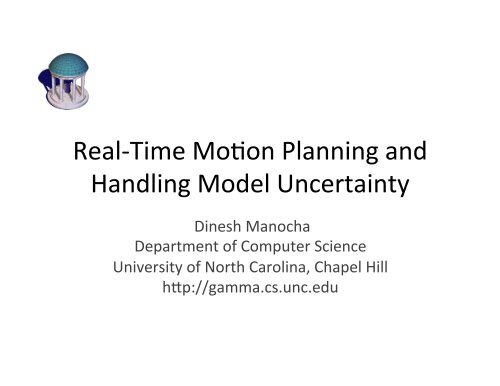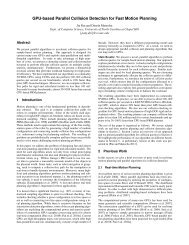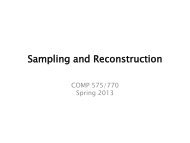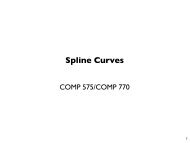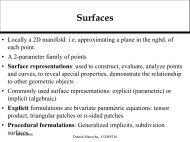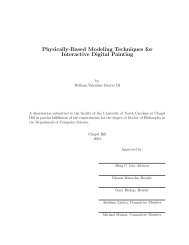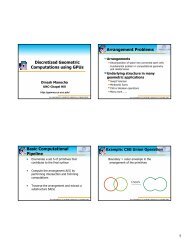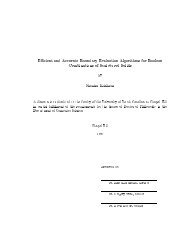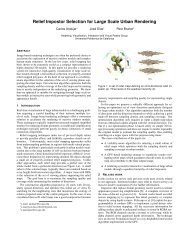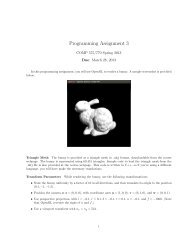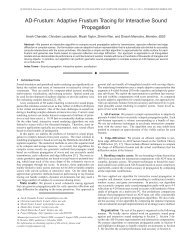Slides - Geometric Algorithms for Modeling, Motion, and Animation
Slides - Geometric Algorithms for Modeling, Motion, and Animation
Slides - Geometric Algorithms for Modeling, Motion, and Animation
Create successful ePaper yourself
Turn your PDF publications into a flip-book with our unique Google optimized e-Paper software.
Real-‐Time Mo,on Planning <strong>and</strong><br />
H<strong>and</strong>ling Model Uncertainty<br />
Dinesh Manocha<br />
Department of Computer Science<br />
University of North Carolina, Chapel Hill<br />
hBp://gamma.cs.unc.edu
Collaborators<br />
• Sachin ChiBa (Willow Garage)<br />
• Chris,an Lauterbach<br />
• Jia Pan
Sample-‐based Planners<br />
• Collision checking is one of the major boBlenecks<br />
• Can take more than 90% of total running ,me
Prior work on collision checking<br />
• Fast algorithms <strong>for</strong> convex polytopes<br />
• Bounding volume hierarchies <strong>for</strong> general polygonal<br />
models<br />
• De<strong>for</strong>mable models<br />
• Mul,ple systems<br />
I-‐Collide, RAPID, PQP, DEEP, SWIFT, SWIFT++,<br />
De<strong>for</strong>mCD, Self-‐CCD,…..
Prior work on collision checking<br />
• Fast algorithms <strong>for</strong> convex polytopes<br />
• Bounding volume hierarchies <strong>for</strong> general polygonal<br />
models<br />
• De<strong>for</strong>mable models<br />
• Mul,ple systems<br />
I-‐Collide, RAPID, PQP, SWIFT, SWIFT++, De<strong>for</strong>mCD, Self-‐<br />
CCD,…..<br />
But these systems assume exact model representa,on<br />
using triangulated models
Prior work on collision checking
Mo9on Planning <strong>for</strong> Physical Robots<br />
• Planning a complex 3D task requires complex 3D models<br />
– Task level planning vs. mo,on planning<br />
• Task execu,on needs real-‐,me feedback to follow dynamic/<br />
uncertainty environment<br />
• How to trans<strong>for</strong>m arbitrary tasks to a sequence of mo,on<br />
planning problems? Link with Percep,on?
M o t i o n P l a n n i n g<br />
The too weak link with perception<br />
Mo9on Planning <strong>for</strong> Physical Robots<br />
The real world is not so nice<br />
as virtual reality!<br />
The perceived world!<br />
• Robots use sensors such as cameras, Lidar, tac,le, which provide only par,al<br />
in<strong>for</strong>ma,on about the physical world<br />
I E E E I C R A M a y 5 , 2 0 1 0<br />
• Sensor <strong>and</strong> actuator error; real-‐,me data processing [Laumond 2010]
Mo9on Planning <strong>for</strong> Physical Robots<br />
• Collision checking on noisy point cloud data<br />
• Real-‐,me high DOF planning using graphics hardware
Mo9on Planning <strong>for</strong> Physical Robots<br />
• Collision checking on noisy point cloud data<br />
• Real-‐,me high DOF planning using graphics hardware
Robot Sensors: Data Collec,on<br />
Cameras
Robot Sensors: Data Collec,on<br />
Laser Scanners
Demonstra,on of Point Cloud Data<br />
Integra,on with PR2 Sensors (Willow Garage)
Reconstructed Point Clouds
Kinect Sensors<br />
http://graphics.stan<strong>for</strong>d.edu/~mdfisher/Kinect.html
Kinect Reconstruct Result<br />
http://www.cs.washington.edu/ai/Mobile_Robotics/projects/rgbd-3d-mapping/<br />
http://groups.csail.mit.edu/rrg/index.php?n=Main.VisualOdometryForGPS-DeniedFlight
H<strong>and</strong>ling Noisy Point Cloud Data<br />
• Planning, naviga,on <strong>and</strong> grasping<br />
• Scene reasoning<br />
• Noisy data<br />
• Real-‐,me processing
Errors in Point Clouds<br />
Discretization (sampling) error
Errors in Point Clouds<br />
Position error
Point Cloud Collision Detec,on<br />
In-collision In-collision ?
H<strong>and</strong>ling Point Cloud Collision:<br />
Two Methods<br />
Point Cloud Collision<br />
Mesh Collision
Mesh Reconstruc,on => Collision<br />
Reconstruction<br />
Mesh Collision<br />
Reconstruction is more difficult then collision detection<br />
Solve an easier problem by conquering a more<br />
difficult one?
Mesh Reconstruc,on => Collision<br />
• Reconstruc,on process is not robust, <strong>and</strong> is<br />
sensi,ve to noise <strong>and</strong> high order features<br />
• Reconstruc,on process is slow (few seconds)<br />
• Error in reconstructed result can be amplified<br />
by subsequent collision checking<br />
• The final result is YES/NO answer, which is<br />
sensi,ve to noise.
Our Solu,on<br />
• Return to the basic defini,on of collision-‐free<br />
– Two objects are collision-‐free if they are separable<br />
by a con,nuous surface <strong>and</strong> is in-‐collision when<br />
such surface does not exist.
Classifica,on-‐based Collision Detec,on<br />
• Find a separa,ng surface that separates two<br />
points clouds as much as possible
Collision Detec,on based on Robust<br />
Classifica,on<br />
• We find the op,mal (i.e. minimize the<br />
separa,ng error) separa,ng surface using a<br />
SVM-‐like algorithm<br />
• Use supervised machine learning methods <strong>for</strong><br />
geometric classifica,on<br />
• Different from st<strong>and</strong>ard SVM: each training<br />
data point has noise – corresponds to robust<br />
classifica,on in machine learning
St<strong>and</strong>ard SVM<br />
Robust Classifica,on<br />
Robust Classification: aware of noise
Per-‐point Collision Probability<br />
• Collision probability: the probability that one<br />
point is on the wrong side of separa,ng<br />
surface.<br />
• Robust classifica,on computes collision<br />
probability <strong>for</strong> each single point sample
Probabilis,c Collision between Two<br />
• For each object<br />
Objects<br />
– Cluster the points <strong>and</strong> only keep one point in each<br />
cluster: compute collision probability <strong>for</strong><br />
independent points<br />
– Filter out points whose collision probability is<br />
small: compute points with reliable collision<br />
probability (i.e. collision result will not change<br />
much when noise level changes).<br />
– Overall object collision probability
Three Collision Cases<br />
Deep collision In-contact Large distance<br />
Collision probability<br />
near 1<br />
Easy<br />
Collision probability<br />
near 0.5<br />
Difficult: small noise will<br />
bring reverse of yes/no answer<br />
Collision probability<br />
near 0<br />
Easy
Results: Small Noise<br />
Deep Collision Configurations<br />
In Contact Configurations (Difficult)<br />
Large Distance Configurations<br />
Very few configurations are in the difficult region
Results: Large Noise<br />
Deep Collision Configurations<br />
In Contact Configurations (Difficult)<br />
Large Distance Configurations<br />
More configurations are in the difficult region!
PR2 Robot Sensor Results<br />
Deep Collision Configurations<br />
In Contact Configurations (Difficult)<br />
Large Distance Configurations<br />
same distance to obstacle ßàcollision probability with wide spread.
Benefit<br />
• Speed is comparable to mesh collision<br />
detec,on algorithm (50-‐100ms per query) -‐-‐-‐<br />
faster than mesh reconstruc,on, especially on<br />
large point clouds<br />
• In-‐contact configura,ons corresponds to a set<br />
with non-‐zero measure in C-‐space; however,<br />
mesh-‐based collision checking on such objects<br />
would result in a zero-‐measure set
Benefit<br />
• Speed is comparable to mesh collision<br />
detec,on algorithm (50-‐100ms per query) -‐-‐-‐<br />
faster than mesh reconstruc,on, especially on<br />
large point clouds<br />
• In-‐contact configura,ons corresponds to a set<br />
with non-‐zero measure in C-‐space; however,<br />
mesh-‐based collision checking on such objects<br />
would result in a zero-‐measure set
Mo9on Planning <strong>for</strong> Physical Robots<br />
• Collision checking on noisy point cloud data<br />
• Real-‐,me planning using graphics hardware
Mobile Manipulators: Onboard Computa,on<br />
2x Onboard Servers<br />
Processors :: Two Quad-<br />
Core i7 Xeon Processors (8<br />
cores)<br />
Memory :: 24 GB<br />
Externally Removable Hard<br />
Drive :: 1.5 TB<br />
Internal Hard Drive :: 500<br />
GB
PR2 Compu,ng Hardware<br />
The 1.3 kWh battery<br />
system can run the servers<br />
<strong>and</strong> robot at full tilt <strong>for</strong> 2<br />
hours (i.e. power is 650W).
Real-‐,me Mo,on Planning<br />
• Complex task execu,on needs real-‐&me<br />
feedback<br />
• Dynamic / uncertain / de<strong>for</strong>mable<br />
environments or apply uncertain control.
Commodity GPU<br />
• Many-‐core programmable processors<br />
– High number of independent cores (16 -‐ 30)<br />
– Wide vector units on each core (8 -‐ 32)<br />
– High b<strong>and</strong>width, high latency main memory<br />
– Much higher per<strong>for</strong>mance/power ra,o<br />
• Synchroniza,on between cores<br />
– Only via main memory<br />
– No memory consistency model!
Current GPU Architectures<br />
Host<br />
Grid<br />
Block (0, 0)<br />
Registers<br />
Shared Memory<br />
Thread (0, 0)<br />
Global Memory<br />
Registers<br />
Thread (1, 0)<br />
Block (1, 0)<br />
Registers<br />
Shared Memory<br />
Thread (0, 0)<br />
Registers<br />
Thread (1, 0)<br />
Each processor only execute one warp (32) of threads<br />
on a block. The number of parallelizable blocks is<br />
restricted by the shared memory used per block.
Why GPUs?<br />
• GPUs can be faster/cheaper/smaller over CPU<br />
• Newest genera,on Fermi GPU can<br />
provide another 2-‐3 ,mes speed-‐up.
GPGPU: GPUs <strong>for</strong> non-‐graphics<br />
applica,ons<br />
• GPU has been an apparent c<strong>and</strong>idate to speed-‐up<br />
general purpose large-‐scale computa,ons …<br />
– Numerical linear algebra<br />
– Sor,ng [Owens et al. 2008]<br />
– Fourier Trans<strong>for</strong>ms [Leischener et al. 2009]<br />
– Acous,c Wave Equa,on [Mehra et al. 2010]<br />
– Delayed Duplicate Detec,on <strong>for</strong> memory<br />
management [Edelkamp et al. 2010]<br />
– Search [Joseph Kider et al. 2010]<br />
– Database query processing [Govindaraju et al. 2004;<br />
He et al. 2009]<br />
– Low degree-‐of-‐freedom mo,on planning [Hoff et al.<br />
2000; Pisula et al. 2000]
Challenge <strong>for</strong> Real-‐,me Planner on GPUs<br />
• Algorithmic boBlenecks<br />
– Algorithm complexity is high w.r.t. DOFs <strong>and</strong><br />
topology of configura,on space<br />
• Architecture restric,ons<br />
– GPU is not an ideal Parallel R<strong>and</strong>om Access<br />
Machine (PRAM) Processor<br />
– Parallel planning algorithms designed <strong>for</strong> mul,-‐<br />
core or mul,ple CPUs do not map well to GPU<br />
architectures
Probabilis,c Roadmap Method<br />
• Use GPUs <strong>for</strong> real,me mo,on planning (g-‐<br />
Planner)<br />
• g-‐Planner uses probabilis,c roadmap method<br />
(PRM) as the underlying mo,on planning<br />
algorithm<br />
– suitable to exploit the mul,ple cores <strong>and</strong> data<br />
parallelism on GPUs<br />
– Easier to extend <strong>for</strong> h<strong>and</strong>ling uncertainty
Probabilis,c Roadmap Method
Our GPU-‐based Pipeline
BoBlenecks in Mo,on Planner
Parallel Sampling<br />
• Real parallel r<strong>and</strong>om generator based on<br />
cryptographic hashing [Tzeng et al. 2007]:<br />
– No internal state (i.e. value at i + 1 does not<br />
depend on value at i)<br />
• Proper,es of cryptographic hashing<br />
– decorrela,ng – similar inputs, dissimilar outputs<br />
– uni<strong>for</strong>m probability – all outputs likely to occur<br />
• CHash(thread id) – white noise generator
Parallel Sampling<br />
CHash<br />
Thread ids Uni<strong>for</strong>m r<strong>and</strong>om numbers<br />
• Trans<strong>for</strong>ma,ons can be per<strong>for</strong>med<br />
independently on uni<strong>for</strong>m samples in each<br />
thread
BoBlenecks<br />
• High number of collision queries<br />
– Compute milestones <strong>and</strong> local<br />
planning<br />
– Need more than 1,000,000 even <strong>for</strong><br />
simple roadmaps<br />
• K-‐nearest neighbor query<br />
– Difficult when number of samples is<br />
large
Hierarchy-‐based Collision Query<br />
• Build or update hierarchies<br />
• Traverse hierarchies recursively<br />
– Start with root nodes<br />
– Do nodes overlap?<br />
• Yes: Inner nodes: recursive <strong>for</strong>mula,on<br />
• Per<strong>for</strong>m primi,ve overlap tests<br />
Triangle-‐triangle<br />
overlap test
• Construct BVH on GPU<br />
BVH Construc,on<br />
– Uses thread <strong>and</strong> data parallelism<br />
– Fast linear BVH construc,on [Lauterbach et al. 2009]<br />
• Basic idea: turn the BVH construc,on problem<br />
into the sor&ng problem along a space-‐filling<br />
curve (i.e. Morton Curve)<br />
– Points close on curve are close in 3D space<br />
– Radix-‐sort is fast on GPU<br />
• Interac,ve construc,on on current GPUs (
Parallel Collision Query<br />
• In mo,on planning, we can per<strong>for</strong>m high<br />
number of collision queries in parallel<br />
• Naive parallelism is used in previous CPU-‐<br />
based parallel planner [Akinc et al. 2005, Amato<br />
et al. 1999]<br />
– Per-‐thread per collision or per-‐thread per<br />
con,nuous collision
GPU-‐based Parallel <strong>Algorithms</strong><br />
• Collision queries<br />
– Use Bounding Volume Hierarchy (BVH) <strong>for</strong><br />
accelera,on<br />
– H<strong>and</strong>le mul,ple samples in parallel<br />
– Lazy planning: delay collision queries in local planning<br />
un,l necessary<br />
• K-‐nearest neighbor search<br />
– Locality-‐sensi,ve hashing based approach<br />
– Turn global search into local search<br />
– Linear complexity
Hierarchies
GPU Memory Model<br />
• Shared memory is fast, BUT limited (16K-‐48K)<br />
• The more shared memory used <strong>for</strong> one block,<br />
the less parallelism<br />
– Parallel block num ≤<br />
overall<br />
shared memory size<br />
shared memory used per block<br />
– Basic parallel BVH algorithm needs one stack (>32)<br />
<strong>for</strong> each thread, so 32 * n <strong>for</strong> a n-‐thread block<br />
(BAD!)
Data-‐dependent Condi,onal Branch<br />
(Per warp)<br />
Happens frequently in BVH traverse (BAD!)
Our Solu,ons<br />
• Parallel Collision-‐Packet Traversal<br />
– 50%-‐100% speed up over basic GPU method<br />
– Simple to implement <strong>and</strong> can be used with basic<br />
parallel collision algorithms<br />
• Parallel Collision Query with Workload<br />
Balancing<br />
– 5-‐10x speed up over basic GPU method<br />
– More complicated to implement
Parallel Collision-‐Packet Traversal<br />
• Cluster collision queries into several groups<br />
– Queries in one group will have similar traverse<br />
path<br />
– Groups are further divided into small warps<br />
• For queries in the same warp traverse the<br />
BVTT in the same special order<br />
– One stack per block<br />
– Coalesced memory access <strong>and</strong> cacheable<br />
– No branch divergence
Query Clustering<br />
• Find clusters to minimize<br />
where are cluster centers <strong>and</strong> clusters<br />
are of the size<br />
• Constrained clustering, difficult to solve<br />
• We only approximate it with k-‐means <strong>and</strong><br />
then divide into chunk-‐size clusters.
Packet’s Traverse Order<br />
• We need an op,mal traverse order <strong>for</strong> the<br />
packet to avoid addi,onal BV collisions.<br />
• No,ce that only the en,re packet do not<br />
overlap with one BV can the packet stop.<br />
• Using greedy heuris,cs<br />
– The probability <strong>for</strong> one traverse order P is<br />
where<br />
– Traverse the children node with large first
Parallel Collision Query with Workload<br />
Balancing<br />
• Each thread executes more fine-‐grained tasks:<br />
overlap test between two BVs or leaf triangles<br />
• The tasks are stored in one large queue, <strong>and</strong><br />
keep a local task queue <strong>for</strong> each block.<br />
AD<br />
AE AF<br />
BE CE<br />
CF<br />
BE AD<br />
AE AF<br />
BE CE<br />
BE<br />
CF<br />
Queue
Workload Balancing<br />
• Different queries will stop ayer different<br />
number of BV checks<br />
• Different local queues will have different<br />
number of tasks<br />
• Queue is nearly full or emptyà processor idle<br />
à balancing
Core 1<br />
Task 0<br />
Task i<br />
External<br />
Task<br />
Pools<br />
…<br />
pump kernel<br />
abort or<br />
con,nue<br />
Global<br />
Task Pools<br />
Global<br />
Task Pools<br />
……<br />
Task k<br />
U9liza9on<br />
Core k<br />
…<br />
Task k+i<br />
manage kernel<br />
balance kernel<br />
abort or<br />
con,nue<br />
……<br />
……<br />
……<br />
Task n<br />
Core n<br />
…<br />
Task n+i<br />
abort or<br />
con,nue<br />
full<br />
empty<br />
full<br />
empty<br />
task kernel
Per<strong>for</strong>mance Analysis<br />
• We can prove that our parallel algorithms on<br />
GPU are work efficient, i.e. not slower than<br />
the serial implementa,on.<br />
• Tserial> Tbasic > Tpacket > Tworkload ≈ Tserial/#processor<br />
Tserial<br />
Tbasic<br />
Tpacket<br />
Tworkload
K-‐nearest neighbor computa,on<br />
• Many previous approaches are based on<br />
spa,al structures, e.g. Kd-‐tree, GNAT, BVH<br />
– Worst space/,me complexity is square<br />
– Complexity grows exponen,ally according to the<br />
dimensionality<br />
• Our solu,on<br />
– Based on locality-‐sensi,ve hashing (LSH) <strong>and</strong><br />
cuckoo hashing<br />
– Turn global KNN search into local search<br />
– Linear complexity
Hashing-‐based KNN search<br />
• Approximate method<br />
– Approximated KNN is sufficient roadmap<br />
construc,on<br />
• Basic idea<br />
– LSH: group samples poten,ally to be closed<br />
– Cuckoo hashing: efficient storage <strong>and</strong> query<br />
• At least 10x speed-‐up (beBer <strong>for</strong> large dataset<br />
<strong>and</strong> high-‐dimensional data)
Graph Search<br />
• Currently per<strong>for</strong>m parallel BFS/DFS<br />
• A* or more advanced method (ARA* etc) can<br />
be used to improve the search [Kider et al.<br />
2010]
Benchmarks
Timing Results: Collision Checking<br />
• Compared with basic GPU method<br />
[Lauterbach et al. 2010]<br />
50000 collision<br />
queries<br />
Basic GPU Collision-‐packet Workload<br />
Balancing<br />
Traverse balance<br />
Piano 224 130 68 3.7<br />
Large-‐piano 710 529 155 15.1<br />
Helicopter 272 226 56 2.3<br />
Humanoid 2316 1823 337 126
Timing Results: Local Planning<br />
• Compared with basic GPU method (per-‐thread<br />
per query method) (ms)<br />
Local Planning<br />
Computa9ons<br />
Basic GPU Collision-‐packet Workload<br />
Balancing<br />
Traverse balance<br />
Piano 2076 1344 1054 34<br />
Large-‐piano 7587 6091 1139 66<br />
Helicopter 7413 4645 913 41<br />
Humanoid 8650 8837 6082 1964
Overall Per<strong>for</strong>mance<br />
• Our parallel GPU-‐based algorithms can<br />
per<strong>for</strong>m about 500K collision queries per<br />
second on $400 NVIDIA Fermi Card (100X<br />
faster than prior methods)
PRM Mo,on Planning on GPUs<br />
• 100x accelera,on can be observed<br />
OOPSMP on Intel 3.2GHz i7 (single core) CPU ($600)<br />
gPlanner on NVIDIA GTX 285 GPU ($400)
Preliminary Results<br />
• Scale well on mul,-‐core GPUs (log-‐log plot)
Preliminary Results<br />
• Scalability of LSH based KNNS (log-‐log plots)
Applica,ons to PR2 Model<br />
• DOF 12<br />
• Compared with CPU (ms)<br />
CPU GPU<br />
Milestone Comp. 15,952 392<br />
Local Planning<br />
(include self-‐<br />
collision)<br />
643,194 6,803<br />
• 500 samples<br />
– Per<strong>for</strong>m mo,on planning in simple scenarios in<br />
~300ms
Results
Results: PR2 Model
Conclusions & Future Work<br />
• Collision checking on noisy point cloud data<br />
• Real-‐,me planning using graphics hardware<br />
• Integrate with Physical Robots (PR2)
• Funding agencies<br />
– ARO<br />
– NSF<br />
Acknowledgements<br />
– DRAPA/RDECOM<br />
– Intel
Thanks


